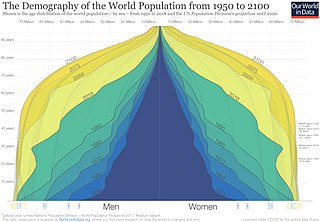Related Research Articles

Demography is the statistical study of human populations: their size, composition, and how they change through the interplay of fertility (births), mortality (deaths), and migration.
A cohort study is a particular form of longitudinal study that samples a cohort, performing a cross-section at intervals through time. It is a type of panel study where the individuals in the panel share a common characteristic.

The UCL Institute of Education (IOE) is the faculty of education and society of University College London (UCL). It specialises in postgraduate study and research in the field of education and is one of UCL's 11 constituent faculties. Prior to merging with UCL in 2014, it was a constituent college of the University of London. The IOE is ranked first in the world for education in the QS World University Rankings, and has been so every year since 2014.
A longitudinal study is a research design that involves repeated observations of the same variables over long periods of time. It is often a type of observational study, although it can also be structured as longitudinal randomized experiment.

Ian John Deary OBE, FBA, FRSE, FMedSci is a Scottish psychiatrist known for work in the fields of intelligence, cognitive ageing, cognitive epidemiology, and personality.
The National Longitudinal Surveys (NLS) are a set of surveys sponsored by the Bureau of Labor Statistics (BLS) of the U.S. Department of Labor. These surveys have gathered information at multiple points in time on the labor market experiences and other significant life events of several groups of men and women. Each of the NLS samples consists of several thousand individuals, many of whom have been surveyed over several decades.
The National Survey of Health & Development is a Medical Research Council (MRC) longitudinal survey of people born in Britain in March 1946. It is "the longest continually running major birth cohort study in the world and is one of the longest-running studies of human development. "
The Health and Retirement Study (HRS) is a longitudinal survey of a representative sample of Americans over age 50 conducted by the Survey Research Center (SRC) at the Institute for Social Research (ISR) at the University of Michigan in Ann Arbor and supported by the National Institute on Aging (NIA). The study interviews approximately 20,000 respondents every two years on subjects like health care, housing, assets, pensions, employment and disability. The study is managed through a cooperative agreement between the NIA, which provides primary funding, and the ISR, which administers and conducts the survey. Beginning in 2012, HRS began adding genetic information from consenting participants to its database. The economic measures captured by the data in the HRS are regarded as being of very high quality.
Birth to Twenty (BT20) is Africa's largest and longest running study of child and adolescent health and development. The study is a birth cohort study, and in 1990 began to track the development of 3,273 newborn infants. According to supporter, University of Witwatersrand, Johannesburg, BT20 is colloquially nicknamed "Mandela's Children" as the program began following Nelson Mandela's release from prison. As the name suggests, the study plans will continue to monitor its subjects until they are twenty years old (2010). As of 2008, the study was still active.
Cognitive epidemiology is a field of research that examines the associations between intelligence test scores and health, more specifically morbidity and mortality. Typically, test scores are obtained at an early age, and compared to later morbidity and mortality. In addition to exploring and establishing these associations, cognitive epidemiology seeks to understand causal relationships between intelligence and health outcomes. Researchers in the field argue that intelligence measured at an early age is an important predictor of later health and mortality differences.
Jeremiah Noah Morris was a Scottish epidemiologist who established the importance of physical activity in preventing cardiovascular disease.
ESDS Longitudinal is a specialist service of the Economic and Social Data Service (ESDS), led by the UK Data Archive at the University of Essex and the ESRC United Kingdom Longitudinal Studies Centre (ULSC), jointly funded by the Joint Information Systems Committee (JISC) and the Economic and Social Research Council (ESRC).
The Millennium Cohort Study (MCS) is a longitudinal survey conducted by the Centre for Longitudinal Studies (CLS) at the University of London, following the lives of a sample of about 18,818 babies born in the UK in the year 2000–2001.
The 1970 British Cohort Study (BCS70) is a continuing, multi-disciplinary longitudinal survey monitoring the development of babies born in the UK during the week of 5–11 April 1970.
The National Child Development Study (NCDS) is a continuing, multi-disciplinary longitudinal study which follows the lives of 17,415 people born in England, Scotland and Wales from 17,205 women during the week of 3–9 March 1958. The results from this study helped reduce infant mortality and were instrumental in improving maternity services in the UK.

The Avon Longitudinal Study of Parents and Children (ALSPAC), also known as Children of the 90s and formerly the Avon Longitudinal Study of Pregnancy and Childhood, is a cohort study of children born in the former county of Avon, England during 1991 and 1992. It is used by researchers in health, education and other social science disciplines.

James William Bruce Douglas was a British social researcher. Douglas was responsible for the National Survey of Health & Development that in turn led to other national birth cohort studies, such as the National Child Development Study, the 1970 British Cohort Study and the Millennium Cohort Study.

Jean Golding, FMedSci, is a British epidemiologist, and founder of the Avon Longitudinal Study of Parents and Children (ALSPAC), also known as "Children of the Nineties". She is Emeritus Professor of Paediatric and Perinatal Epidemiology at the University of Bristol.
The Growing Up in New Zealand longitudinal study (GUiNZ) is New Zealand's largest ongoing cohort study. It recruited and follows 6,846 New Zealand children born between 2009 and 2010—approximately 11 per cent of all children born in the country in that period. The project aims to create an in-depth summary of what life is like for children in New Zealand, and what factors affect their happiness, health, and development. The study also seeks to represent the diversity of modern-day New Zealand families, filling in current knowledge gaps on the health and wellbeing of Māori, Pasifika, and other communities. The study is run from the University of Auckland and is funded primarily by the New Zealand Government.
Mia Lilly Kellmer Pringle was an Austrian-British child psychologist. She was the founding director of the British National Children's Bureau, where she oversaw the influential National Child Development Study. Over the course of her career, Pringle advocated for the needs and rights of children both through her research-informed policy work and in her many books and articles about early childhood development.
References
- ↑ Wadsworth, Michael; Kuh, Diana; Richards, Marcus; Hardy, Rebecca (2006-02-01). "Cohort Profile: The 1946 National Birth Cohort (MRC National Survey of Health and Development)". International Journal of Epidemiology. 35 (1): 49–54. doi: 10.1093/ije/dyi201 . ISSN 0300-5771. PMID 16204333.
- ↑ Power C, Elliott J (2006). "Cohort profile: 1958 British Cohort Study". International Journal of Epidemiology. 35 (1): 34–41. doi: 10.1093/ije/dyi183 . PMID 16155052.
- ↑ Elliott J, Shepherd P (2006). "Cohort profile: 1970 British Birth Cohort (BCS70)". International Journal of Epidemiology. 35 (4): 836–43. doi: 10.1093/ije/dyl174 . PMID 16931528.
- ↑ Pearson, Helen (2016). The Life Project. UK: Allen Lane an imprint of Ppenguin Books. p. 5. ISBN 978-1-846-14826-2.
- ↑ Bynner, J and Steedman, J. (1995) Difficulties with Basic Skills. Findings from the 1970 British Cohort Study. London: Basic Skills Agency.
- ↑ Bynner, J and Paxton, W.(2001) The Asset-Effect. London: IPPR